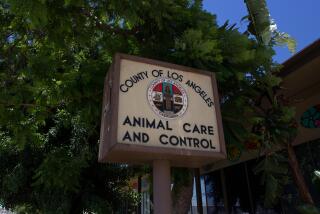Shelter Steps Up Distemper Fight
- Share via
To stem a feline distemper outbreak that has plagued Orange County’s largest animal shelter since October, all cats with symptoms of the highly contagious disease will be destroyed and healthy cats isolated in separate cages, county health officials said Thursday.
And in a reversal of existing policy, officials at the county shelter in Orange were ordered Thursday to begin immediate vaccinations for all cats kept at the shelter. Shelter officials had opposed that step as ineffective and costly.
In a further effort to eradicate the disease’s spread, shelter staffers were installing individual cages to replace gang cages that could be a breeding ground for the disease.
“Sick cats have to be put down,” said Mike Spurgeon, director of regulatory health services for the county’s Health Care Agency. “Starting this week we are inoculating every cat off the truck, and once we give them a physical and determine they are healthy, then we send them to an individual cage.”
The decisions come a week after the county’s Animal Control Advisory Board urged shelter officials to impose a 30-day cat adoption moratorium on all cats under 5 years of age, because cats placed by the shelter were dying and infecting pets at their foster homes.
The actions highlight a tumultuous period for the county-run animal shelter, which has been under fire from its advisory board and the public for reacting too slowly to the distemper outbreak.
In a bureaucratic shake-up this week, broad-scale decisions for the shelter also were taken out of the hands of its interim director Mark McDorman and the county’s top veterinarian, Dr. Richard Evans.
Spurgeon, who oversees the shelter, and his boss, Health Care Agency Director Michael Schumacher, are making the decisions about how to handle the outbreak of cat distemper, also called pan leukopenia, in consultation with advisory board members, veterinarians and shelter staff, Spurgeon said.
Dr. William Grant, a Garden Grove veterinarian who heads the advisory board, applauded the decisions.
“If cats are demonstrating any signs attributable to pan leukopenia, those cats should be euthanized,” he said. “We know it is almost 100% fatal and is highly contagious.”
It is expensive, costing at least $500 to treat the disease, which is spread through contact with contaminated feces in food, water or litter boxes, Grant said. Vaccination costs about $1 a cat, and he recommended that owners vaccinate their pets.
Spurgeon said it will cost the county about $60,000 to $70,000 to upgrade the shelter, sterilize cages and deal with the disease. The money will come from other agency budgets.
The outbreak poses tricky problems for health care officials because they have limited space to house cats separately, and the shelter gets about 20 new cats a day. Unlike local shelters, the county facility must take all cats and dogs brought to it by the public.
Spurgeon acknowledged that the shelter has individual cages for only 58 cats adjacent to the animal clinic and that cats probably will be euthanized in large numbers if the county cannot quickly add more separate cages or shorten the moratorium period. The county already euthanizes about 10,700 of the 13,000 cats it takes in each year.
On Thursday, there were 65 cats at the shelter, 37 in separate cages and the rest in five gang cages. Workers were installing 12 temporary cages as quarantine space for an additional dozen cats. These temporary cages were being stacked inside two of the 7-foot-high gang cages so they would be sheltered from sun and rain.
Spurgeon said about 200 cages plus a container to keep sun and rain out were ordered this week but could take a month to arrive.
Health care agency officials also are considering reducing the moratorium period so that healthy, vaccinated cats can be adopted. The incubation period for pan leukopenia is three to 14 days, so it may be possible to have a quarantine period of just over two weeks for vaccinated animals, Spurgeon said.
Dr. Todd Kopit, a Stanton veterinarian who serves on the advisory panel, agreed.
“A 15-day period would be the minimum. After that they could be put up for adoption and we would feel more comfortable housing them together,” he said.
*
Times staff writer Kate Folmar contributed to this report.
More to Read
Sign up for Essential California
The most important California stories and recommendations in your inbox every morning.
You may occasionally receive promotional content from the Los Angeles Times.










